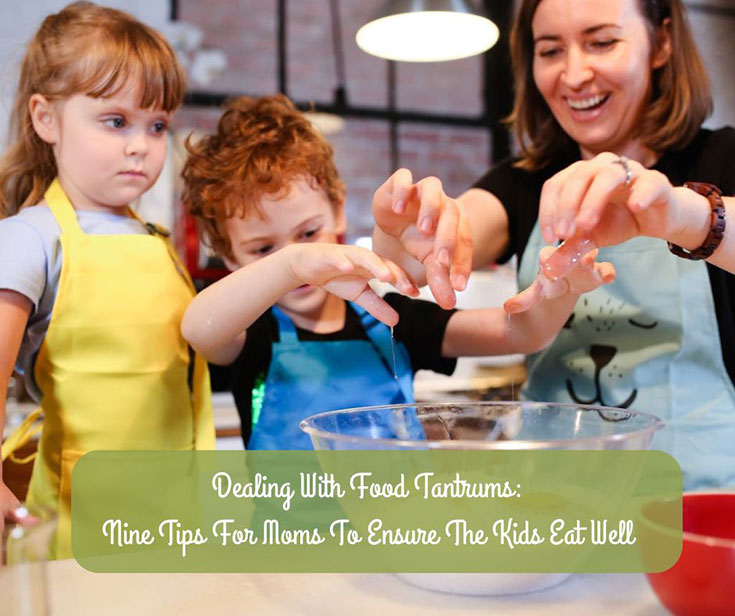Being a mom is a challenging yet rewarding experience, filled with countless joys and hurdles. Among these, one of the greatest challenges is ensuring that your kids eat healthy meals at home. Children often have picky eating habits and are tempted by unhealthy snacks. Busy family schedules can make it difficult to find the time to prepare balanced meals. However, it’s not an impossible task. This article will guide you with nine tips to help you make sure your kids eat well.
- Introduce New Foods Gradually
Kids are naturally wary of unfamiliar foods, so introducing new foods gradually is crucial. Start with small portions and pair them with familiar favorites. For instance, if your child loves pasta, try adding a new vegetable to the sauce or as a side dish.
Avoid pressuring kids into trying new foods, as this can backfire. Instead, offer new foods in a relaxed manner, and if they refuse, don’t make a fuss. It might take several attempts before they develop a taste for something new.
- Create Innovative and Delicious Dishes Kids Will Love
Children are more likely to eat healthy foods if they look and taste appealing. One way to achieve this is by creating innovative and delicious dishes that kids will love. Try, for instance, a homemade taco meat recipe. Tacos are quick, versatile, and can be filled with a variety of healthy ingredients.
To make the ground beef taco meat, brown one pound of ground beef in a skillet, then drain the excess grease. Add two tablespoons of taco seasoning and a cup of water. Simmer the mixture until thickened, which takes about ten minutes. This protein-packed dish can be served with tortillas, lettuce, cheese, and salsa or even frozen for later use.
Creating meals like these, which are both nutritious and kid-friendly, helps in changing their perception of healthy eating. With dishes like tacos, kids can also be encouraged to customize their plates with toppings like avocado, tomatoes, or corn, ensuring they eat a well-rounded meal.
- Involve Kids in Meal Preparation
Getting children involved in meal preparation is another effective strategy. When kids participate in cooking, they feel a sense of ownership and are more likely to try what they’ve helped create. Start by choosing recipes together, allowing them to select dishes that excite them.
During cooking, let them wash, peel, or chop vegetables with child-safe tools. They can also assemble their plates creatively, which adds an element of fun to the process. For instance, if you’re making a salad, let them choose the toppings or the dressing. If it’s a pizza night, let them add their favorite vegetables or herbs. This hands-on approach not only teaches valuable cooking skills but also encourages them to eat what they’ve helped prepare.
- Make Mealtime Fun
Creating a positive atmosphere around mealtime can significantly influence a child’s eating habits. Make mealtime fun by using cookie cutters to shape fruits, veggies, or sandwiches into appealing designs. You can also create colorful plates by offering a variety of textures and colors.
Another idea is to plan themed meals, like “Rainbow Plate Night,” where each food must represent a different color. This creative approach adds excitement and curiosity to the dinner table, making kids more open to trying new things.
- Set a Positive Example
Children often mimic their parents’ behavior, so setting a positive example is essential. Eat healthy foods yourself and avoid labeling foods as “good” or “bad.” Instead, emphasize the importance of balance and moderation.
If kids see their parents enjoying fruits, vegetables, and other nutritious foods, they’re more likely to follow suit. Show enthusiasm for trying new dishes and maintain a positive attitude, even if they initially refuse a particular food. This will help them build a healthy relationship with food over time.
- Offer Healthy Snacks
Kids love snacking, and snacks can be an excellent opportunity to sneak in some extra nutrition. Instead of letting them munch on sugary treats or salty chips, offer readily available, nutritious snacks that are just as appealing.
Fresh fruits like apple slices served with nut butter or a sprinkle of cinnamon can be a satisfying snack. Greek yogurt with berries provides protein and antioxidants, while veggie sticks with hummus or guacamole offer a crunchy, savory alternative to chips. Making these healthy snacks easily accessible in the fridge or pantry encourages kids to grab them whenever hunger strikes.
- Avoid Sugary Drinks
Sugary drinks can be a significant roadblock to healthy eating, often providing empty calories without any nutritional value. Kids love the taste of sodas and fruit juices, but these beverages are packed with sugar. Instead, introduce healthier alternatives like infused water, smoothies, and diluted juices.
By gradually shifting them away from sugary drinks, you can reduce their sugar intake while keeping them hydrated.
- Establish a Regular Meal Routine
A consistent meal routine helps kids know what to expect and reduces the chances of them filling up on unhealthy snacks throughout the day. Establishing set meal and snack times creates structure and helps regulate their appetite.
Sitting down together for family meals as often as possible fosters positive eating habits and creates a relaxed environment where kids are more likely to try new foods. Make it a rule to minimize distractions like TV or electronic devices during mealtimes. This allows everyone to focus on their food and engage in meaningful conversations, reinforcing the importance of healthy eating and family time.
- Reward Healthy Eating (Without Food)
Using non-food rewards can positively reinforce healthy eating habits without associating desserts or treats with “good” behavior. A sticker chart where kids earn stickers for trying new foods or finishing their veggies can motivate them to be more adventurous.
Other non-food rewards could include extra playtime, a fun outing, or choosing the next family activity. However, it’s crucial to avoid using desserts as a reward for finishing vegetables, as it can create an unhealthy relationship with food. Instead, focus on positive reinforcement that encourages kids to make healthier choices willingly.
Conclusion
Feeding kids healthy meals is no small feat, but it’s achievable with patience, creativity, and a positive mindset. With these practical tips, moms can ensure that their kids not only eat well but also develop a taste for healthy, wholesome foods. Be consistent, positive, and supportive on this journey, and you’ll find that your kids can enjoy and embrace healthy eating, paving the way for lifelong well-being.







These are all such great tips. My kids ate pretty good when they were younger, but now they’ve become more picky. I try to get them to at least try new foods, and sometimes they end up liking it. I know how frustrating it can be when they don’t want to try anything.
It’s so important for kids to have a healthy diet. I’m glad my son is not a picky eater and loves to try new things and understand the importance of healthy foods.
These seem like good tips and steps towards helping children build a healthy relationship with food!
These are great points. One of my kids has always been a picky eater, and food has always been a battle, so it is good to have positive strategies.
Such great tips. It can be hard how and what to feed kids especially when they’re picky.
Those are great and helpful tips. I have a friend whose child is very picky and always has tantrums when eating. I will give her these tips. Thank you for sharing.
Introducing new foods gradually and involving kids in meal prep sound like game-changers. Can’t wait to try out those ground beef tacos!
These are wonderful tips to teach your children to eat a healthy diet. I can say that my kids were not picky eaters, at times I had to try new menus and recipes. that over time they loved.
You are so right that getting kids to eat what’s good for them can be a challenge. Thanks for sharing these tips for all the Moms struggling with this problem.
i am glad my kids did not throw too many tantrums for food.. but then again, i think providing them a variety of dishes over the week helped them enjoy the food